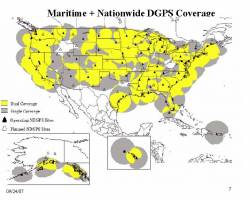
The Nationwide Differential Global Positioning System (NDGPS) program has been salvaged from the political limbo in which it has resided for more than a year.
Following completion of an assessment by the U.S. Department of Transportation (DoT), the agency has decided to continue full NDGPS operations. Currently, 86 stations are operating with support from three federal agencies: the U.S. Coast Guard (USCG, 39 sites), the Army Corps of Engineers (9 site), and the DoT (38 sites operated and maintained by the USCG under contract).
The Nationwide Differential Global Positioning System (NDGPS) program has been salvaged from the political limbo in which it has resided for more than a year.
Following completion of an assessment by the U.S. Department of Transportation (DoT), the agency has decided to continue full NDGPS operations. Currently, 86 stations are operating with support from three federal agencies: the U.S. Coast Guard (USCG, 39 sites), the Army Corps of Engineers (9 site), and the DoT (38 sites operated and maintained by the USCG under contract).
Discussions are ongoing regarding the future funding mechanism for inland NDGPS and will be addressed in future budget submissions, according to Paul Feenstra, a public affairs officer in the DoT’s Research and Innovative Technology Administration (RITA), which has overseen the program for the interim since early 2007 when responsibilities were transferred from the Federal Railroad Administration.
The 2007 DoT operating plan halted all new NDGPS site construction and allocated only $5 million in the Fiscal Year 2008 budget to continue maintenance and operations until a final decision could be made on the inland portion of the system. At that time, the agency indicated plans to continue the NDGPS stations along the coasts and inland waterways.
The decision continuing the full NDGPS system was announced at the National Space-Based PNT Executive Committee Advisory Committee meeting on March 27. It was based in part on the results of an NDGPS user assessment conducted by RITA, following a plan announced in the Federal Register notice, assessing the current user needs and systems requirements for the inland component of NDGPS.
The notice listed 10 factors for consideration. Information was gathered on these factors through public responses to the notice (including responses from state and local governments, the private sector, and the nonprofit sector), and through quantification of the mission requirements of other Federal agencies using inland NDGPS. More than 120 comments, mostly supportive, came in response to the Federal Register notice. This information formed the backbone for the assessment, which informed the DOT decision.
The system’s design is based on the USCG’s DGPS maritime service that began initial operation in 1996 and transmits real-time differential corrections from the reference stations on a medium frequency maritime radiobeacon band of 285-325kHz. Only a handful of additional stations need to come on-line to complete full national coverage.



